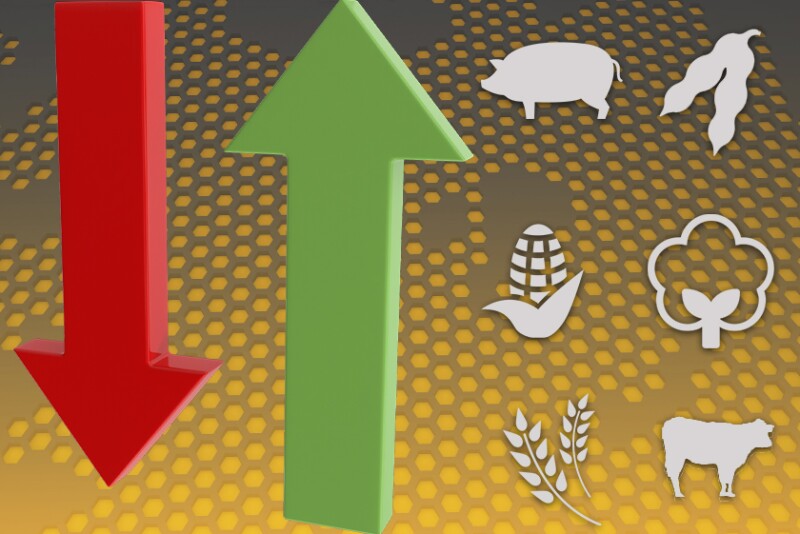GRAIN CALLS
Corn: 3 to 7 cents lower.
Soybeans: 2 cents higher to 6 cents lower.
Wheat: 15 to 25 cents higher.
GENERAL COMMENTS:
Spring wheat futures are expected to open with sharp gains after gapping higher overnight following a surprisingly large drop in USDA’s crop condition ratings. Corn and soybean futures are expected to open lower as recent U.S. Midwest rainfall improves crop prospects, overshadowing slightly weaker-than-expected condition ratings. In other markets, the U.S. dollar index was up slightly and near two-month highs reached last week, while Nymex crude oil futures were lower, but near 2 1/2-year highs.
There are few changes in the Midwest weather outlook for the week ahead, World Weather Inc. said. Last night’s GFS model run suggested “a particularly significant rain event” late Wednesday into Friday in southern Iowa, Illinois and Missouri, along with decreased rainfall prospects from central Iowa through northern Illinois Saturday into Monday.
Consultant Michael Cordonnier made no change to his U.S. corn yield estimate of 177.5 bu. per acre, though his bias moving forward is neutral to lower. “A condition rating of 70% good to excellent is generally considered about the minimum needed to achieve trend line corn yields or better,” he said in a report. “The current rating is below that point, and it is also below the long-term average rating for this time of the year, so I continue to feel there is a downside risk to the corn yield.”
Cordonnier lowered his estimate for Brazil’s corn harvest by 2 million metric tons (MMT), to 90 MMT, and said bias is neutral to slightly lower going forward. Harvest is just getting started, and early yield reports vary widely but have generally been below what had been expected.
China announced it will auction 18,207 MT of imported corn on June 25, according to Sinograin. Demand at a similar auction last week was strong. The auctions are one of China’s many efforts to cool food price inflation.
CORN:
USDA’s crop progress report yesterday afternoon showed the U.S. corn crop at 65% “good” to “excellent” condition as of Sunday, down from 68% a week ago and 72% a year ago. Analysts on averaged expected a 66% “good” to “excellent” rating. When USDA’s weekly condition ratings are plugged into the weighted Pro Farmer Crop Condition Index (CCI; 0 to 500-point scale, with 500 representing perfect), the corn crop dropped 5.6 points to 366.7 points and is now 8.6 points below its five-year average. Chart levels to watch include December futures’ low last week at $5.30 1/2.
SOYBEANS:
USDA reported 60% of the U.S. soybean crop in “good” to “excellent” condition as of Sunday, down from 62% a week ago and 70% a year ago and meeting analyst expectations. On our weighted CCI, the soybean crop declined 3.4 points to 354.6 points and is 9.1 points under the norm for this date. Chart level to watch include last week’s low in November soybeans at $12.40 1/2.
WHEAT:
USDA’s latest crop condition ratings underscored the toll taken on spring wheat acreage by recent extreme heat and dryness in the Northern Plains. The spring wheat crop’s condition slipped to just 27% “good” to “excellent,” down from 37% a week ago and far exceeding the 2-percentage point drop expected by analysts. The spring wheat CCI rating plunged 27.8 points over the past week to 277.0 points, 91.1 points below the five-year average. September HRS wheat futures reached a two-week high overnight at $8.02 1/4, the contract and left a gap in the daily chart between today’s low of $7.87 and yesterday’s high of $7.79 1/2.
USDA’s weekly crop progress report showed the winter wheat harvest 17% completed as of Sunday, up from 4% the previous week and lower than the five-year average of 26%.
CATTLE: Steady-firm
HOGS: Steady-weak
CATTLE:
Traders are watching to see how cash cattle markets develop this week, with packers not expected to be too aggressive on bidding ahead of Friday’s monthly USDA Cattle on Feed Report. Live steers in top U.S. cattle states averaged $122.84 yesterday, equal to last week’s average, according to USDA. Boxed beef prices continued slipping amid slower retail purchases. Choice cutout values averaged $321.20 yesterday, down $2.08 from Friday. Chart levels to watch include August futures’ contract high of $125.775, reached June 16, and last week’s low of $120.00.
HOGS:
Firmness in cash markets may help lean hog futures take a consolidation pause from recent sharp declines. National direct carcasses yesterday averaged $123.57, up 97 cents from the end of last week, according to USDA. Pork cutout values averaged $120.76, up 11 cents from Friday but down from the seven-year high near $135 hit June 8. USDA’s next Quarterly Hogs & Pigs Report Thursday will offer insight into pork supplies in the second half of 2021 and beyond.

